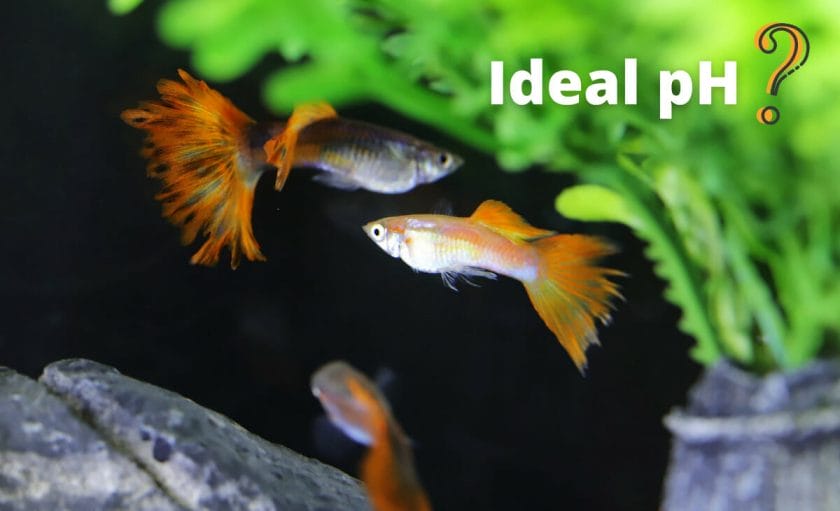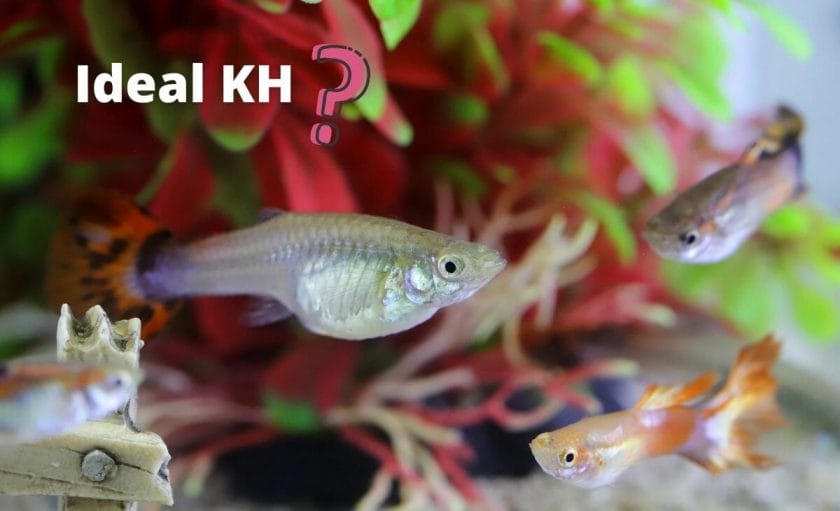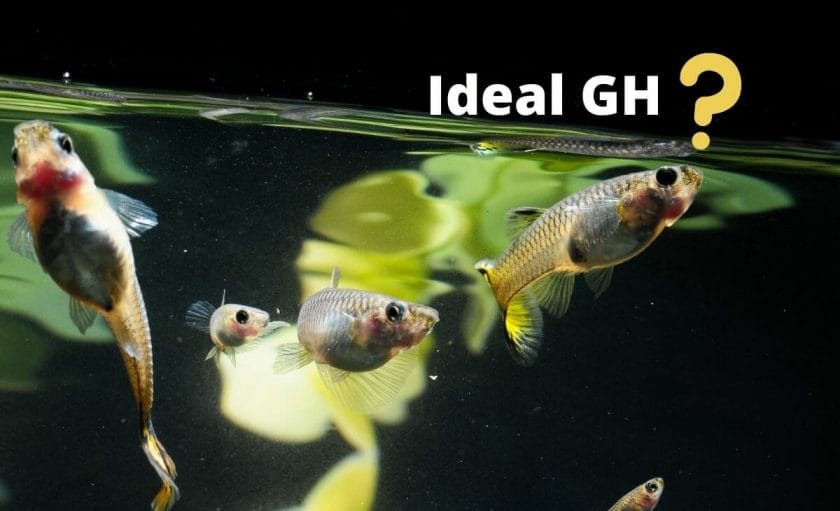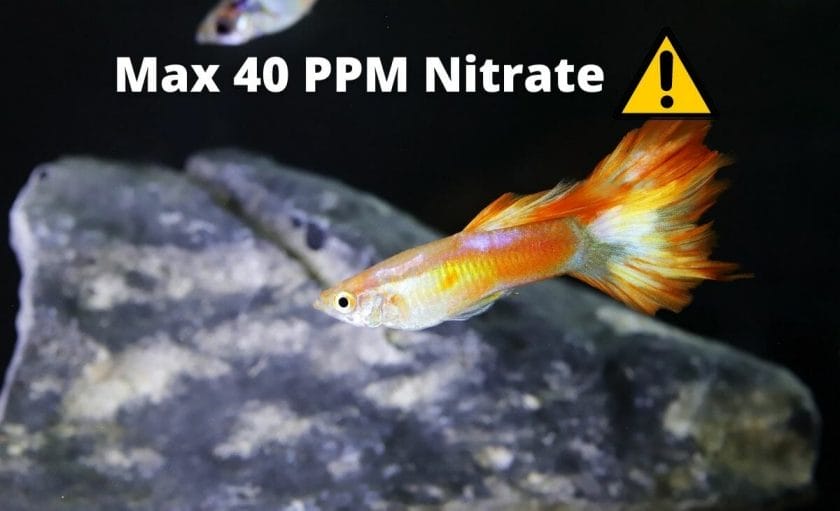Getting your first guppy tank is very exciting. Guppies are very hardy fish but to keep them happy and healthy in your tank you’ll need to maintain the ideal water parameters in the tank.
In this article, I’m going to tell you the best water parameters for guppies.
| Water Parameters | Ideal Range |
|---|---|
| Temperature | 72-82°F (22-28°C) |
| pH | 6.8 – 7.8 |
| GH | 6 to 8 dGH or 100-140 ppm |
| KH | 4 to 8 dKH or 70 to 140 ppm |
| Ammonia | 0 |
| Nitrite | 0 |
| Nitrate | Less than 40 ppm |

So these are the ideal water parameter rages for guppies.
Now you may be wondering, how can I measure the water parameters in my tank, how to raise or lower the water parameters if they’re not in the ideal range. And if they’re in the ideal range then how can I maintain the water parameter.
No worries, this is what I’m going to cover in the rest of the article.
Keep reading.
Table of Contents
What is the best temperature for guppies?

Naturally, guppies are found in tropical environments.
That’s why they are called tropical fish.
In the tropical environment, the temperature is generally warmer throughout the year.
The temperature in tropical climates is around 64.4° Fahrenheit (18° Celsius).
That’s why guppies need warmer temperatures in the fish tank.
The ideal temperature range for guppies is between 72° to 82° Fahrenheit (22° to 28° Celsius).
What will happen if the temperature in the fish tank is is too low (below 72° Fahrenheit)?
If the temperature of the water is lower than 72° Fahrenheit then this can cause multiple problems.
- First of all, it will decrease the fish’s activity level.
- Keeping guppies at lower temperatures also makes them susceptible to diseases. Some diseases could be severe and it can also lead to death.
- If you keep guppies in cold water then it also affects their breathing
What will happen if the temperature in your guppy fish tank is too high (more than 82° Fahrenheit)?
If the temperature in your guppy fish tank is more than 82° Fahrenheit then the water will not carry sufficient dissolved oxygen.
So if you keep the temperature of your guppy fish tank is more than 82° Fahrenheit then your guppies will struggle to get oxygen. And they will suffocate!
If the temperature in your guppy fish tank is too hot for a long time then this can also lead to the death of guppies.
Now you know how important it is to maintain the ideal temperature range in your guppy fish tank, you may be wondering, how to measure the temperature in your guppy fish tank so you can keep it in the ideal range.
How to measure the temperature in your guppy fish tank
The easiest way to measure and keep track of the temperature in your guppy fish tank is to install an aquarium thermometer in your guppy fish tank.
Aquarium thermometers are very cheap. You can buy them from Amazon here
How to lower the temperature in your guppy fish tank?
There are several ways to lower the temperature in your guppy fish tank.
- First of all, you should remove the lid from your guppy fish tank to cool the water in the tank
- If you are using an aquarium heater in your guppy fish tank then you should turn down your aquarium heater to lower the temperature
- You should also turn off the aquarium lights in your fish tank because aquarium light can also heat up the water in the tank is especially if you are using fluorescent bulbs
- You can also do a partial water change of your guppy fish tank to lower the temperature in the tank
So these are various ways of lowering the temperature in your guppy fish tank.
Actually, I have written a detailed article covering 15 ways to lower temperature in an aquarium you can check it out here.
How to raise the temperature in your guppy fish tank?
If you found that the temperature in your guppy fish tank is lower than 72° Fahrenheit (22° Celsius) then you will need to raise the temperature in the tank.
The easiest way to raise the temperature in your guppy fish tank is to use an aquarium heater.
There are several aquarium water heaters available in the market.
When it comes to choosing an aquarium heater for your guppy fish tank make sure to choose a reliable and heater from a good brand.
I recommend this aquarium water heater (link to Amazon) it comes with a built-in thermostat and it is very reliable. You can check it out at Amazon here
What is the best pH for guppies?

The ideal pH range for guppies is between 6.8 to 7.8.
pH is basically a measure of the number of hydrogen ions present in the aquarium water.
- pH range 7 is considered neutral.
- If the pH of the water is less than 7 then it is considered acidic.
- And if the pH is more than 7 then it is considered basic.
How to measure the pH in your guppy fish tank?
You can easily measure the pH in your guppy fish tank using an API water test kit (link to Amazon)
API pH water test kit comes with 2 ph bottles-
- Regular pH bottle
- Super high pH water
How to measure the pH of the water using API regular pH bottle?
- First of all, you should take a test tube and put 5 ml of water of your aquarium water into the test tube
- Now add three drops of the pH solution from the regular pH bottle into the test tube
- Now you should invert the tube a few times
- Now you will notice that the color of the water will change
- Once the color of the water in the test tube is changed then you will need to compare it with the color shades given in the chart that comes with the API water pH test kit
- And this is how you can test the pH of your aquarium water with the test kit
If you noticed that the color of the water in the test tube is dark blue then, in that case, you will need to again test your aquarium water for pH using the API super high pH bottle
How to measure the pH of your aquarium water using an API super high pH bottle?
- Testing the pH of your aquarium water using the super high pH bottle is similar to the method used for testing the water pH using API regular pH bottle
- First of all, you will need to take 5 ml of your aquarium water in a test tube
- Now you will need to put 5 drops of the pH solution from the super high pH bottle into the test tube
- Now you will need to invert the test tube a few times
- At this point, the color of the water in the test tube should change. Once the color is changed you will need to compare the color with the color chart given with the API water pH test kit.
How to lower the pH of the water in your guppy fish tank?
If you noticed that the pH of your guppy fish tank water is more than 7.8 then in that case you will need to lower the pH in the fish tank.
There are a few ways to lower the pH in your aquarium water
- You can add natural driftwood in your guppy fish tank to lower the PH in the tank. Natural driftwood contains tannins which help to lower the pH in your aquarium water
- You can also add peat moss or peat pellets in your aquarium filter to lower the pH of the water in your guppy fish tank. The peat moss also contains tannins which help to lower the pH in your aquarium water
- A safe way to lower the pH of your guppy fish tank water is to do minimal water changes. Doing minimal water changes will acidify the water naturally and this will lower the pH of your aquarium water.
- You can add filtered water through the reverse osmosis system in your guppy fish tank to lower the pH of the water in the tank. The reverse osmosis system removes all the minerals from the water. So if you do a partial water change with the reverse osmosis filtered water then this can help to lower the pH in your guppy fish tank.
- Before adding the reverse osmosis filtered water into your guppy tank make sure to dechlorinate the water. And also make sure to check the pH of your water before adding the water.
- After adding reverse osmosis filtered water in your guppy fish tank if you noticed that the pH of your aquarium water is very low then in that case you can use Seachem equilibrium (link to Amazon) to increase the pH
How to raise the pH of the water in your guppy fish tank?
If you found that the pH of the water of your guppy fish tank is below 6.8 then, in that case, you will need to raise the pH of the water.
There are a few ways to raise the pH in your guppy fish tank water
- You can use crushed coral (link to Amazon) or dolomite gravel as a substrate for your guppy fish tank to raise the pH of the guppy fish tank water. The crushed coral and dolomite gravel are calcium carbonate based. They will slowly dissolve in your aquarium water and help in raising the pH in your aquarium water
- Instead of using crushed coral or dolomite gravel as substrate, you can also fill that up in a mesh bag and then put it in the filter of your aquarium. This method will also work to raise the pH of your aquarium water
- Remember the crushed coral and dolomite gravel will eventually get completely dissolved in your aquarium water. And then you will need to replace them. How often you will need to replace generally depends on your water quality. Generally, you don’t need to replace them for months. Replace them between 6 to 12 months depending on your water quality.
- You can also place wonder shells in your guppy fish tank to harden the water and raise the pH of your water
- You can also use products such as Seachem equilibrium to raise the pH of your guppy fish tank water.
What is the best KH for guppies?

Kh stands for carbonate hardness.
It basically measures the carbonate and bicarbonate ions in water.
KH acts as a buffer for pH swings or spikes.
KH is measured in degrees and ppm. One degree KH is equaled to 17.9 ppm.
The ideal KH for guppies is 4 to 8 dKH or 70 to 140 PPM.
pH swings or spikes stress the guppies in your tank. That’s why you want to avoid the pH swings. And KH helps with it. That’s why you want to maintain the ideal KH range in your guppy tank.
To maintain the KH, first, you’ll need to know the current KH in your guppy fish tank.
How to measure KH in your aquarium water?
You can easily measure the KH in your aquarium water using an API KH test kit (link to Amazon)
- To measure the KH in your guppy tank using the KH test kit, take 5 ml of the tank water in a test tube.
- Now add the KH solution into the test tube one drop at a time until the color of the water changes to orange/dark yellow
- Once the color of the water in the test tube changes to orange, at that point, you’ll need to count the number of drops you’ve added in the test tube. And that’s the KH of your aquarium water. For example, let’s say if you have added 5 drops of the solution then the KH of your aquarium water is 5 dKH
Is too much KH bad for fish?
More KH is not bad for fish. KH acts as a buffer for pH spikes so if you have more KH then you’re assured that you’ll not see any pH spikes in your tank which is a good thing!
However, over time the KH levels will drop in your tank. If the KH in your tank water is too low then you’ll need to raise it to prevent pH spikes.
Generally, you don’t want KH lower than 2 dKH in your tank.
How to raise the KH in your guppy tank?
There are a few ways of raising the KH in your guppy aquarium
- You can use Seachem Alkaline Buffer (link to Amazon) to increase the KH in your guppy tank. This is one of the safest ways to increase the KH cause this product is specifically designed to increase the KH in aquariums.
- You can mix crushed coral, dolomite rock, limestone, or aragonite in the substrate of your guppy tank to raise the KH in the tank. This is a very slow method of raising the KH because the crushed coral, dolomite rock, limestone, or aragonite will slowly get dissolved in the water of your tank to raise the KH.
- And it can take anywhere between 2 to 8 weeks to raise the KH in your tank. But it is a good thing because when it comes to changing the water chemistry of any fish tank a general rule to follow is the slowly you change it the better. Because suddenly changing water chemistry stresses the fish.
What is the best GH for guppies?

GH stands for general hardness.
GH basically measures how hard the aquarium water is.
Specifically, it measures the calcium and magnesium ions in aquarium water.
Calcium and magnesium are essential for the proper growth, development, functioning of guppies.
So you need some GH levels in your guppy tank.
How much GH is ideal for guppies?
GH is measured in PPM or Degrees.
Guppies can tolerate a wide range of GH.
Generally speaking, they can do well in a range of 4 to 8 degrees or 70 to 140 ppm.
However, guppies prefer GH on a higher side. So you should try to keep GH levels at around 6 to 8 degrees or 120 to 140 ppm.
If you’re planning to breed guppies then you’ll need even higher GH in the guppy breeding tank (Around 8 to 12 degrees)
When should you measure GH in your aquarium?
You must measure the GH in your guppy tank if you notice any signs of disease in the tank.
Besides, you should measure the GH during the monthly maintenance of your guppy tank.
How to measure the GH of your guppy tank water?
You can easily measure the GH in your guppy tank water using an API GH test kit.
- To measure GH using API GH test kit, take 5 ml of your aquarium water in a test tube.
- Now add a drop of API GH solution into the test tube and invert the test tube.
- Repeat the above process until the water in the test tube changes to green. And don’t forget to count the drops you’ve added in the test tube.
- Once the water in the test tube turned green, count the drops you’ve added in the test tube and that’s how many degrees GH you’ve in your guppy tank. For example., if the water turned green after adding 5 drops then the GH levels in the tank is 5 dGH.
How to lower GH levels in a guppy tank?
Guppies can tolerate a very high range of GH. They can tolerate GH as high as 20 dGH.
So generally, you don’t need to lower GH in a guppy tank.
That being said, an effective way to lower the GH in your guppy tank is to add Reverse osmosis (RO) filtered water into your tank during the next water change.
The RO system will remove all the minerals from the water. So when you add RO filtered water into the tank, you’re basically diluting the GH levels in your tank. And that’s the way to lower GH in a guppy tank.
How to raise GH levels in a guppy tank?
The simplest way to raise GH in a guppy tank is to use Seachem equilibrium.
To raise the GH of your tank by 3 GH in a 20 gallon tank, just add a tablespoon of Seachem equilibrium in your tank.
You’ll need to adjust the quantity of Seachem equilibrium according to the level of GH you want to raise and the tank size.
Tip: To dissolve the Seachem equilibrium completely, first mix it in a jar of about 1 liter aquarium water and then add it in your tank.
Ammonia

Ammonia is very harmful to your guppies.
Even a slight level of ammonia can lead to the death of the fish in your tank.
So you should always make sure that your tank doesn’t contain any ammonia in your tank.
If your tank is properly cycled then you’ll not see any ammonia levels in your tank.
That’s why you should always cycle your tank before adding any fish into the tank.
But what if you already have some guppies in the tank?
In that case, you can use the fish-in cycling method to cycle your tank.
How to check ammonia in a guppy tank?
You can easily check the ammonia level in your tank using an aquarium water test kit.
I recommend API ammonia test kit (link to Amazon). It is a liquid-based test kit so it is pretty accurate.
How to test ammonia levels in a tank using API ammonia test kit?
- First of all, you’ll need to take 5 ml of your aquarium water and add it in the provided test tube.
- The API ammonia test kit comes with two solutions.
- So first you’ll need to add eight drops of the first solution into the test tube
- Then you’ll need to add eight drops of the second solution into the test tube
- Now you’ll need to put the cap on the test tube and shake the test tube rigorously
- Now you’ll need to wait for about 5 minutes
- After five minutes you’ll notice that the color of the water is changed.
- Now you’ll need to hold the test tube against the color chart provided in the kit to check exactly how much ammonia you have in your tank.
How to get rid of ammonia in a guppy tank?
There are several ways to get rid of ammonia in a guppy tank
1. Partial water change
As soon as you notice some ammonia level in your tank you should immediately do a partial water change of about 30%-50% of your aquarium water to reduce and get rid of ammonia.
2. Improve the filtration in your guppy tank
Your aquarium filter doesn’t only remove the physical impurities but also provides a place for beneficial bacteria, the bacteria that reduces ammonia in a fish tank.
Beneficial bacteria live in the sponge of the filter.
So to reduce ammonia you’ll need more beneficial bacteria in your tank. And to increase beneficial bacteria colonies you’ll need to add either a bigger or an additional filter in your tank.
For example, if you have a HOB filter in your tank then you can add a sponge filter in the tank to provide more space for beneficial bacteria.
Besides these ways, here are other ways to get rid of ammonia in a fish tank.
Nitrite

Just like ammonia, nitrite is harmful to guppies. So you don’t want any nitrite in your tank.
How to check nitrite levels in a guppy fish tank?
You can check the nitrite levels in your guppy tank using an API nitrite test kit.
How to test nitrite levels in a guppy tank using API nitrite test kit?
- First of all, you need to get 5 ml aquarium water in the provided test tube.
- The API nitrite test kit comes with two solutions.
- So first you’ll need to add 5 drops of the first solution into the test tube.
- Then put a cap on the test tube and invert it a few times.
- Now you’ll need to add 5 drops of the second solution into the test tube
- Now put a cap on the test tube and shake the bottle well.
- Now you’ll need to wait for about 5 minutes for the color of the water in the test tube to change. Usually, the color will be lighter in the beginning and it will get darker as some time passes.
- After five minutes you’ll need to hold the test tube against the color chart provided in the test kit to know how much nitrite is present in your tank.
How to get rid of nitrite in a guppy tank?
There are several ways of reducing and getting rid of nitrite in a guppy tank.
1. Partial water change
Doing partial water change of about 30-50% of your aquarium water will dilute the concentration of nitrite in your tank.
So, as soon as you noticed some nitrite levels in your tank, you should immediately do a partial water change.
2. Add salt
If you noticed nitrite levels in your tank then you can add salt in your tank.
Now adding salt doesn’t really help to reduce nitrite in the tank but it prevents the nitrite from getting absorbed into the red blood cells of guppies.
This is important because if the nitrite got absorbed into the red blood cells of your fish then it will be difficult for them to absorb oxygen.
How much salt you should add in the tank?
You need to be careful when it comes to the quantity of salt you add in the tank because some plants and fish are sensitive to salt.
So you should start with 1 tablespoon of salt per 10 gallons of the tank.
3. Add filter or filter media from a cycled tank
If you noticed nitrite levels in your tank then it is a sign that your fish tank is not cycled.
So, in this case, to instantly cycle your tank you can add filter or filter media from an already cycled tank to introduce beneficial bacteria in your tank.
You could get the filter or filter media from an already cycled tank from your aquarist friend or your local fish store may also give it to you.
The beneficial bacteria will convert the nitrite into nitrate, lowering the nitrite levels in your tank.
Nitrate

Unlike ammonia and nitrite, nitrate is not as harmful to your guppies.
Nitrate level up to 40 ppm is considered safe for fish.
How to test nitrate levels in your tank?
You can easily test the nitrate levels in your fish tank using an API aquarium water test kit.
How to test nitrate levels in a guppy fish tank using API nitrate test kit?
- To test your aquarium water for nitrate levels, first of all, take 5 ml of your aquarium water in the provided test tube.
- The API nitrate test kit comes with two solutions
- So, first of all, add 10 drops of solution number 1 into the test tube.
- Now put a cap on the test tube and invert the test tube a few times
- Now shake the second solution bottle rigorously
- And now add 10 drops of the solution into the test tube
- Now put the cab on the test tube and shake the test tube rigorously for at least 1 minute.
- Now, wait for about five minutes for the color to change in the test tube.
- After 5 minutes compare the color of the water in the test tube with this provided sheet to know the nitrate levels in your aquarium.
How to remove nitrate from your guppy fish tank?
There are two ways to remove nitrate from your fish tank.
1. Plant a lot of plants in your fish tank
If you have a lot of plants in your guppy aquarium then the plants will absorb nitrate from your fish tank.
Plants use nitrate as fertilizers and grow in your aquarium.
One thing to note is that you will need to have a lot of plants in your aquarium, especially you’ll need fast growing plants to get rid of all the nitrate from your fish tank.
2. Do a partial water change
You can do a partial water change of anywhere between 30% to 50% of the water of your aquarium to reduce nitrate levels from your fish tank.
One thing to note here is that doing a partial water change doesn’t remove all the nitrate from your fish tank.
But, as I mentioned earlier, your fish can tolerate nitrate levels up to 40 PPM so if you do a partial water change of 50% then you will reduce the nitrate level to around 20ppm if you had 40 PPM nitrate in your tank. And 20 PPM nitrate is safe for the fish.
Conclusion
Maintaining the ideal water parameters in your guppy fish tank is very important for the healthy growth of the guppies in your tank.
So you should always try to maintain the ideal range of the different water parameters in your guppy fish tank.
If you noticed that your fish tank does not have the water parameters in the ideal range then, the tips I mentioned and the different ways I mentioned in this article will help you to get the water parameters in the ideal range.
I hope you found the article helpful.
If you do, please share the article.
Happy fishkeeping!